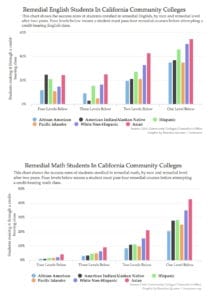The Community-College ‘Segregation Machine’
Meredith Kolodner, Brad Racino, and Brandon Quester, Atlantic, December 14, 2017
{snip}
. . . Hundreds of thousands of community-college students are placed in remedial classes every year, and few get past them, especially few black and Latino students.
“There is no excuse for this,” said Julianna Barnes, the president of Cuyamaca College. “It really is a civil rights issue.”
An analysis of California community-college data by The Hechinger Report and inewsource, both of which produced this story in partnership with The Atlantic, yielded stark results. Only 1 percent of African-American students and 2 percent of Latino students who enrolled in the lowest level of remedial math in 2014 made it through an entry-level college math class within two years (the amount of time it’s supposed to take to earn a full associate’s degree).
At many community colleges, a student can start four levels below college level, which means they must pass four math or English classes before they are allowed to attempt a class that earns them credit toward a bachelor’s degree. Although whites and Asians also have poor pass rates in these low-level remedial classes, the inewsource/Hechinger Report analysis found that Latino students are twice as likely as whites to end up in the lowest level of remedial English. African-American students are five times as likely.
And in math, the situation is even worse. “Having four levels of developmental math is like having a graveyard — almost no one gets out,” said Arturo Martinez, a math professor at El Camino College in Torrance, California.
The impact may be far-reaching: While close to half of all Asian-Americans and 41 percent of whites in California have bachelor’s degrees, the same is true for only 23 percent of African-Americans and 11 percent of Latinos.
The culprit, say experts and academics, has been the rules governing community-college placement decisions. Almost anyone can enroll at a community college in California, but each college has its own process to decide how to place students. Even though state law requires colleges to consider more than just a standardized exam in this process, those exams have long been used as the deciding factor, despite questions about their accuracy.
In October, Gov. Jerry Brown signed a bill mandating that community colleges consider high-school grades, grade-point average, or coursework — not just placement tests — when assigning students to classes. It prohibits these schools from placing students in remedial courses unless those students are “highly unlikely to succeed in transfer-level coursework.”
{snip}
Data show that most students who are placed directly into college-level classes pass at much higher rates than those who go through a remedial sequence, including those who went to low-performing high schools.
A statewide study by an independent nonprofit found that the most powerful predictor of success in college was grade-point average. On average, the study found nearly three-quarters of students with a 2.6 high-school GPA passed college-level English. Roughly the same was true for college-level statistics.
{snip}
“Sometimes when students fail their first test, they don’t come back,” said Rachel Krajewski, who has taught college algebra for the past two years at Cuyamaca. “We’re trying to move them from, ‘I don’t get it, I’m not good enough,’ to ‘I don’t get it yet.’”
The results have been promising. The California Acceleration Project, an advocacy group founded by faculty, reported that pass rates for underprepared students at Cuyamaca in college-level math jumped to 67 percent last year, up from 10 percent the year before. And all racial groups benefited — success rates were four times higher for Latinos, five times higher for white students, and nine times higher for black students.
{snip}
While the California Acceleration Project is aggressively pushing for changes, the Academic Senate for California Community Colleges, also comprised of faculty, opposed the remedial legislation that just passed.
{snip}
California is not alone in grappling with this problem. In the fall of 2015, Tennessee stopped offering remedial classes at all of its public colleges and universities, moving to the co-requisite model where students take college-level courses with an extra support class to help them keep up.
According to the Tennessee Board of Regents, pass rates in math quadrupled, and success rates for students of color were six times higher. English pass rates followed a similar pattern, as did success rates for low-income students, adult students, and students who had entered at low levels of preparedness, as measured by ACT scores.
The City University of New York phased out remedial classes at four-year colleges starting in 1999 and shuffled those students to the system’s community colleges. It launched several pilot programs, like the co-requisite model, with success, and plans to roll out a system-wide overhaul of its remedial system next fall.
{snip}
Other state systems, such as those in West Virginia, North Carolina, and Florida, have begun similar efforts. In August, the four-year California State University system decided to get rid of all remedial classes.
A working group met in November to come up with guidelines for how California’s community colleges must revamp their approach to remedial education. All colleges must implement the changes required by the new law by the fall of 2019.
{snip}
Using students’ high-school transcripts in the placement process meant that 82 percent of new students could take college-level English, instead of 28 percent previously, Smith said. The old way — using placement tests — felt to Smith “like a segregation machine.”
{snip}
The move quadrupled the number of African-American students who were passing entry-level English in one semester.
{snip}
















